The Evolution of Elephants: A Comprehensive Study
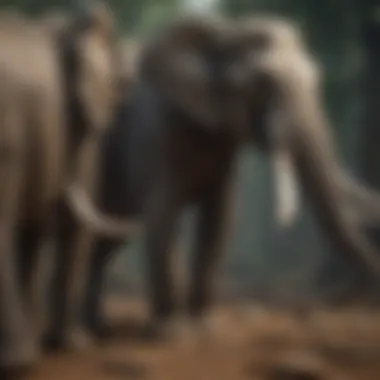
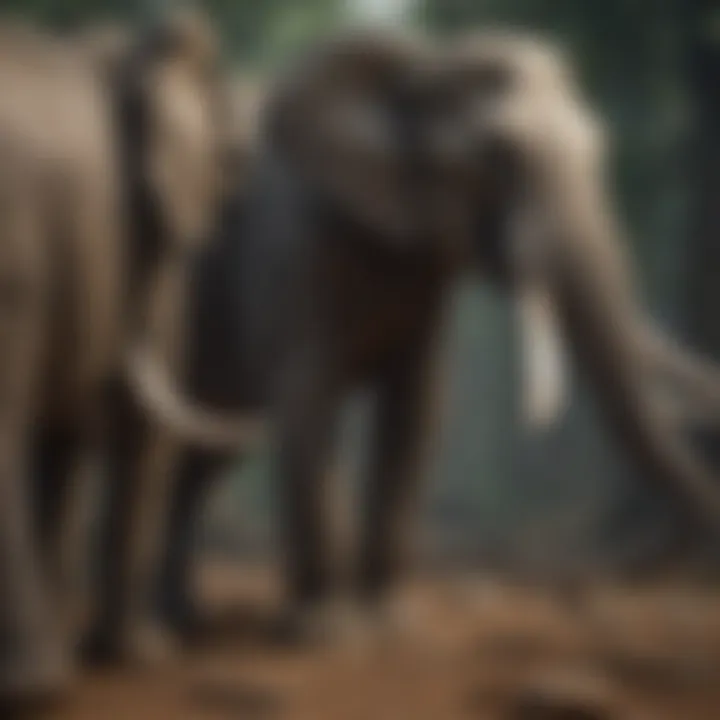
Intro
The journey of elephants through time is as ancient and majestic as the creatures themselves. Understanding how these magnificent animals evolved over millions of years elicits curiosity not only about their origins but also about their current state and significance in ecosystems globally. By unraveling the intricacies of their evolutionary path, we can appreciate the diverse adaptations that have allowed elephants to flourish in different environments, from the savannas of Africa to the dense jungles of Asia.
This exploration combines various scientific methods, including the analysis of fossil evidence and genetic studies, to paint a detailed picture of the factors that have influenced elephant evolution. Furthermore, it places a spotlight on the challenges that current populations face, raising important discussions around conservation efforts. As we embark on this study, we will reveal key insights and implications of this research, enhancing our understanding of these keystone species.
Key Findings
Summary of the Main Results
Research into elephant evolution demonstrates a rich tapestry of lineage shifts and adaptations. Significant findings include:
- Diverse Ancestry: Elephants are part of the order Proboscidea, which dates back over 60 million years. Their ancestors, like the woolly mammoth and mastodon, showcase a variety of forms and functions that thrived in different climates.
- Adaptation Strategies: Elephants developed long tusks and large ears as adaptations to their environments, aiding in foraging and temperature regulation respectively.
- Genetic Insights: Recent genetic studies indicate that Asian and African elephants diverged approximately 7.6 million years ago, leading to distinct species with unique behaviors and social structures.
Significance of Findings within the Scientific Community
The implications of these findings extend beyond the zoological realm. They enhance our understanding of evolutionary biology and provide critical insights into how species adapt to environmental pressures. This research fosters a greater appreciation for biodiversity and informs conservation strategies. Understanding the evolutionary significance of elephants can illuminate broader trends in species adaptation, offering lessons applicable to other endangered species as well.
Foreword to Elephant Evolution
Understanding the evolution of elephants goes beyond mere curiosity; it sheds light on how these magnificent creatures have adapted through the ages. Exploring their evolutionary journey provides insights not just into their past but also into the health of ecosystems where they reside. This section lays the groundwork, emphasizing the significance of elephant evolution in our broader understanding of biodiversity and conservation. With elephants being keystone species, their evolution is tied intricately to the very fabric of their environments.
Defining Elephants and Their Relatives
To comprehend how elephants evolved, one must first define what they are and who their relatives are. Elephants, specifically belonging to the family Elephantidae, encompass three species: the African bush elephant, the African forest elephant, and the Asian elephant. These majestic beings are characterized by their long trunks, massive ears, and tusks made of ivory.
However, elephants have quite a fascinating extended family. They belong to a larger group called Proboscidea, which includes extinct relatives. Notable relatives include woolly mammoths and the mastodon. Additionally, more distant relatives consist of hyraxes and manatees, showcasing a surprisingly diverse evolutionary history. This connection not only emphasizes the adaptability of the Proboscidea but also highlights the intricate tapestry of life’s evolution over millions of years.
An Overview of Evolutionary Theory
At the core of understanding elephant evolution is a solid grasp of evolutionary theory. Proposed first by Charles Darwin, the premise posits that species evolve over time through a process of natural selection. Put simply, those individuals that adapt better to their environment are more likely to survive and reproduce.
This theory is reflected in the evolution of elephants. Their adaptations—from large ears for thermoregulation in hot climates to social structures allowing for cooperative care of young—illustrate how survival influenced their physical and behavioral traits. Moreover, fossil records serve as pivotal evidence, showcasing gradual changes and diversification within the Proboscidea family. These factors feed into the larger dialogue about how species interact, adapt, and alter their environments over time.
"Evolution is not just a theory; it’s a continuous narrative of survival, adaptation and resilience."
In this exploration of elephant evolution, we are poised to dive deeper into their ancient lineage, the milestones of their development, and how environmental factors shaped their adaptations over millennia.
Early Ancestors of Elephants
The early ancestors of elephants play a vital role in understanding the lineage and evolution of these magnificent creatures. Investigating their past unveils how modern elephants have adapted to their surroundings, highlighting the evolutionary principles of survival and resilience. These ancestors provide remarkable insights into the ecological changes that shaped their development, illustrating the significance of environmental pressures on physical and behavioral traits. By studying these early species, we bridge a gap between the present and the ancient, revealing connections crucial to appreciating the elephants we see today.
The Origins of Proboscidea
The origins of the Proboscidea order is like peeling an onion—there are layers of discoveries to uncover. This group, which encompasses modern elephants and their extinct relatives, has a history rich in diversity and adaptation. Emerging approximately 60 million years ago, the first members of this order displayed a striking array of forms and sizes. The shift from being small, deer-like animals to the towering giants we recognize today speaks to an incredible evolutionary journey.
As different habitats and climate changes emerged, these ancestors adapted diversely, leading to the emergence of species suited to various environmental contexts. The adaptations found in these early proboscideans signify the evolutionary pressures that drove their divergence from other mammalian groups. Studying these origins is crucial to understanding how these gentle giants evolved their long trunks and massive bodies, which make them distinct in the animal kingdom.
Fossil Evidence of Early Species
Fossil records offer a window into the past, revealing a plethora of information about early elephantine ancestors. Two notable species, Moeritherium and Deinotherium, paint a vivid picture of what life looked like millions of years ago.
Moeritherium: The Early Water Dweller
Moeritherium is considered one of the earliest known relatives of modern elephants and lived around 37 to 32 million years ago. This semi-aquatic creature possessed a sleek body and a relatively shortened trunk compared to modern elephants. The * key characteristic * of Moeritherium is its adaptation to a life near water. Its limbs suggest it could both swim and walk on land, which highlights an important point: evolution isn’t just about growing larger or stronger; it's also about fitting into a specific niche.
Moeritherium serves as an illustrative choice for this article because it represents the transitionary adaptations vital for survival in variable habitats. Although its relatively poor fossil record poses challenges, discovering more about Moeritherium elucidates how ancestors of modern-day elephants navigated the complexities of their environments.
Deinotherium: A Unique Ancestor
Deinotherium, which roamed the Earth from around 15 to 2 million years ago, offers a different insight into elephant evolution. Often referred to as an “upside-down elephant,” its unique feature—downward-curving tusks—set it apart. These tusks looked quite odd at first glance, but they reveal a functional adaptation, used perhaps for digging or in fights.


The significance of Deinotherium in this context lies in its distinctive anatomical structures that illustrate the varied paths taken within the Proboscidean family tree. Its adaptations showcase how different environmental pressures led to divergent evolutionary strategies. Including Deinotherium in our discussion amplifies the understanding of fluctuating ecosystems and the role of competition among species, enriching our grasp of the broader evolutionary narrative.
"Fossils are the footprints of time, telling stories of life from eons past."
In summary, exploring these early ancestors provides critical insights into elephant evolution. Their unique adaptations and the environmental factors that guided their development highlight the complexity and dynamism of nature’s evolutionary tapestry.
The Rise of Modern Elephants
Understanding the rise of modern elephants offers a fascinating glimpse into the complex tapestry of life on Earth. This section not only showcases the evolutionary changes that have led to today’s elephants but also emphasizes how these magnificent creatures have adapted to their environments over millennia. The evolution of the family Elephantidae is central to this discussion, shedding light on the intricate relationships between Earth’s changing ecosystems and the species thriving within them. This narrative reveals the significance of environmental pressures and genetic divergence in creating the diversity we see in elephants today.
Evolution of the Family Elephantidae
The family Elephantidae encompasses all living elephant species, including the African savanna elephant and the Asian elephant. Modern elephants diverged from their prehistoric ancestors roughly six million years ago, embarking on a unique evolutionary journey. This divergence sets the stage for understanding their adaptations to various habitats, both forested and savannah regions.
- Adaptations: Elephants have developed large ears to dissipate heat, long trunks for foraging, and thick skin for protection. Their physical characteristics reflect their environmental needs and behavioral tendencies, showcasing an intriguing balance between form and function.
- Social Structure: The tight-knit family units of elephants further illustrate their social evolution. Elephants communicate through low-frequency sounds and vibrations, which enhances their ability to engage in complex social interactions. This social fabric has been crucial for their survival and success.
Comparison with Other Proboscideans
When comparing modern elephants to other proboscideans such as woolly mammoths and mastodons, it’s essential to discern how differing environmental adaptations shaped their evolutionary paths.
The Distinct Paths of Woolly Mammoths
Woolly mammoths are a fascinating part of this evolutionary narrative. These creatures were well adapted to the cold, with their thick fur and a layer of fat that allowed them to thrive in icy climates. The contribution of woolly mammoths to our understanding of ice age ecosystems cannot be overstated. Their existence helps researchers comprehend how climate influenced their biology and behavior.
- Key Characteristics: Their iconic long tusks served not only for defense but also for foraging beneath snow for grasses.
- Unique Features: The woolly mammoth’s adaptations designate it as a popular subject of study for scientists exploring extinction events in response to climate shifts. However, its end during the last ice age illustrates the vulnerabilities species face in changing conditions.
Comparison with Modern African and Asian Elephants
Contrasting modern African and Asian elephants with ancient proboscideans provides further insights into evolutionary strategies and environmental adaptability. Both species have characteristics that differentiate them from their extinct relatives.
- Key Trait: African elephants tend to be larger and possess larger ears, ideal for heat regulation in their hot habitats, whereas Asian elephants are slightly smaller with smaller ears.
- Unique Features: The adaptability of these living species is crucial for their survival, especially in rapidly changing environments.
"The survival of modern elephants underscores the importance of preserving their habitats in the face of climate change and human encroachment."
This section serves to illuminate the evolutionary narrative shared with both ancient ancestors and other relatives, emphasizing the dynamic history of these remarkable creatures. Through the lens of modern elephants, we gain invaluable insights into the interplay between evolution and environment, which continues to unfold in today's ecosystems.
Molecular and Genetic Insights
Understanding the molecular and genetic aspects of elephant evolution gives us a clearer picture of how these majestic creatures adapted over millennia. This area of study is crucial because it allows us to trace the lineage of elephants not only through physical traits but also through their genetic makeup. These insights reveal how environmental factors and natural selection have shaped their evolution and diversity.
Techniques in Genetic Study
Modern genetic methodologies are vital in unraveling the complexities of elephant evolution. Techniques such as DNA sequencing, for instance, have transformed our understanding by allowing scientists to analyze genetic material from both ancient fossils and contemporary populations. Among the prominent techniques employed are:
- Mitochondrial DNA Analysis: This examines the genetic material from mitochondria, which is passed down maternally. It provides insights into maternal lineage and migration patterns.
- Whole Genome Sequencing: This comprehensive approach sequences the entire genetic makeup. It enables the identification of specific genes associated with traits like size and adaptability.
- Single Nucleotide Polymorphism (SNP) Analysis: This method focuses on small genetic variations. It helps researchers understand genetic diversity within populations and their evolutionary relationships.
These techniques allow for not just a snapshot of where elephants come from genetically but also inform scientists about how they may respond to environmental changes moving forward.
Phylogenetics: Understanding Relationships
Phylogenetics plays a key role in piecing together the evolutionary puzzle. This branch of study uses genetic data to ascertain the relationships among various elephant species and their ancestors. Through constructing phylogenetic trees, researchers can illustrate how different species diverged from common ancestors, offering a visual representation of evolutionary lineages.
- Cladistics and Divergence: By employing cladistics, researchers categorize species based on shared characteristics, allowing them to infer the most likely evolutionary pathways.
- Historical Insights: Phylogenetic studies have shown that both African and Asian elephants share a relatively recent common ancestor. This insight sheds light on their evolutionary pressures and adaptations.
By mapping these genetic relationships, scientists can predict future evolutionary trends and inform conservation strategies.
"The significance of genetic insights cannot be understated; they provide a robust framework for understanding both past and future trajectories of elephant evolution."
As we engage in this genomic exploration, it's essential to remember the implications that come with it, not only for scientific inquiry but also for conservation efforts aimed at protecting these irreplaceable giants.
Environmental Influences on Evolution
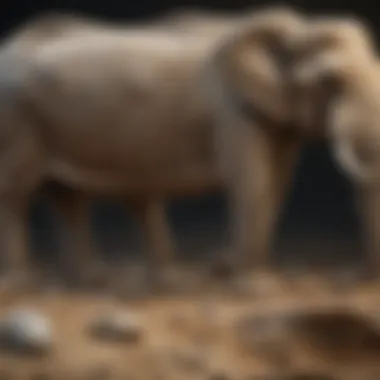
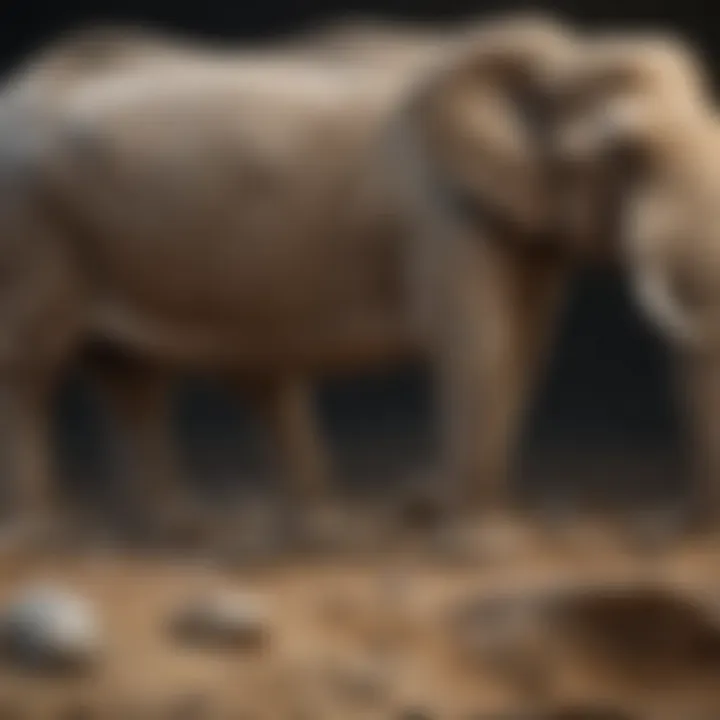
Understanding how environmental factors shaped elephants is crucial in grasping their evolutionary journey. Climate, habitat, and various environmental pressures have played significant roles in the development of the current elephant populations. Elephants, being such adaptable creatures, have evolved traits that allowed them to thrive in diverse ecosystems. By examining the environmental influences, we can unravel the mysteries behind their resilient nature and survival strategies through different epochs.
Climatic Changes and Their Effects
Climatic changes have acted as major catalysts in the evolution of elephants. Over millions of years, temperatures have fluctuated, ice ages have come and gone, and these changes have had profound impacts on the habitats available to elephants. For instance, during warmer periods, forests expanded and spread. Elephants, being large herbivores, adapted their diets accordingly to utilize the resources of these lush environments. Conversely, during colder periods, when habitats shrank and transformed into grasslands or tundras, they had to adjust their foraging behaviors.
Key events like the Pleistocene ice ages offer a window into these adaptations. As glaciers advanced, elephants migrated to find suitable climates, showcasing their resilience and ability to adapt. The implications of these climate shifts helped shape not only their physical characteristics but also social structures within herds.
Habitat Adaptations and Migration Patterns
Elephants are known for their migratory patterns, which have evolved in response to environmental changes. Their movements are often dictated by the availability of food and water sources, making them adept at finding resources across vast areas. The adaptability in movement showcases their intelligence and the social bonds formed in family units.
Impact of Glacial Periods
The glacial periods had a profound effect on habitat availability and distribution. As glaciers expanded, many thriving ecosystems were disrupted, and species that couldn't adapt vanished. Interestingly enough, this significant loss gave rise to new opportunities. Some species of elephants, like the woolly mammoth, evolved distinct traits suited to their cold environments, such as a shaggy coat to insulate them against frigid temperatures. This period taught these massive creatures how to survive in the harshest conditions.
The glacial periods are also notable for fostering genetic diversity among elephants. Isolated populations led to unique adaptations suited for specific environments, contributing to the diversification we see today. Such adaptability becomes not just advantageous but essential in the quest for survival during challenging climatic shifts.
The Role of Grasslands and Forests
The transition between grasslands and forests has been pivotal in shaping elephant behavior and morphology. Grasslands, with their open spaces, allowed for movement and grazing over large distances, while forests provided cover and food resources during different seasons. The adaptability to both environments highlights the versatility of these animals.
In terms of diet, elephants switched between grazing on grasses in open areas to foraging on leaves and fruits in forested zones. Such flexibility has enabled elephants to thrive in changing habitats, revealing their ability to adjust their dietary preferences based on environmental availability. This adaptability grants them the advantage to survive and flourish even as surroundings shift dramatically.
"Nature is relentless and unchangeable, and it's important for species to adapt or face extinction."
The dynamic relationship between elephants and their habitats underscores the interplay of environmental factors in shaping their evolution. Whether through climate changes or shifting ecosystems, elephants continue to showcase a remarkable ability to adapt and persist, contributing to their iconic status in the animal kingdom.
Social Structure and Behavior
Understanding the social structure and behavior of elephants is crucial to fully appreciate their evolutionary journey. Elephants, known for their complex social dynamics, operate within intricate family units that significantly affect their survival and adaptability. In examining their social behavior, one unearths not just the emotional and cognitive capacities of these magnificent creatures, but also how these attributes have been honed over millions of years to thrive in varying environments.
Family Groups and Herd Dynamics
Elephants are deeply social animals, often living in matriarchal family groups known as herds. A typical herd comprises several related females, their offspring, and at times, a few adult males. The dominant female, usually the eldest, serves as the matriarch, guiding the herd through both everyday challenges and tougher situations. Her knowledge—gained throughout her life—is invaluable for the herd's survival. This dynamic nurtures a culture of learning, where younger elephants absorb critical information about foraging, water sources, and migration routes.
- Cooperation: Members of the herd engage in cooperative behavior, often helping each other raise calves. This teamwork extends beyond mere caregiving; it embodies protection and resource sharing.
- Support Systems: When a member of the herd is distressed or sick, the others provide support. Such strong social bonds reinforce group cohesion and stability.
The roles within the herd change over time, particularly as males mature. While females typically remain with their maternal group, males may migrate to form bachelor herds or solitary lives once they reach adulthood. This behavioral split is important to reduce inbreeding and to improve genetic diversity within the population.
Intelligence and Communication
The intelligence displayed by elephants is noteworthy, characterized by problem-solving skills, emotions, and a profound ability for communication. The complexity of their social structure necessitates sophisticated communication methods. Elephants utilize a variety of vocalizations, body language, and even seismic signals to convey messages. Interestingly, they can produce low-frequency sounds—known as infrasound—that travel long distances, allowing them to communicate over several kilometers.
- Vocalizations: From trumpets of excitement to low rumbles of discontent, these vocal signals play a pivotal role in maintaining social ties and coordinating herd movements.
- Body Language: Subtle shifts in posture or gestures can express intentions and emotions. Elephants are keen observers and can interpret the nuances of their companions’ behavior, allowing for a rich social interaction.
- Empathy: Elephants demonstrate what can only be described as empathy. They exhibit care for their dying, even mourning deceased members of their family, which implies a level of emotional intelligence found in few other species.
"When elephants show empathy, it is not just instinctual; it's rooted in their social structure that dictates a collective responsibility to care for others."
As researchers delve further into elephant behavior, the insights gained contribute to understanding these gentle giants and their vital role within ecosystems. This blend of social cooperation and communication illustrates how elephants have adapted over millennia, ensuring they not only survive but also thrive together in their environments.
The Role of Elephants in Ecosystems
Elephants inhabit a number of ecosystems and exert a significant influence on their surroundings. Understanding their role provides insight into why their conservation is crucial not only for the species but also for the overall health of their habitats. As these grand creatures roam forests, savannas, and grasslands, they are not mere inhabitants; they play pivotal roles that maintain ecological balance and biodiversity.
Keystone Species Concept
The concept of keystone species is a cornerstone in ecology. Elephants are considered keystone species due to their profound impact on their environments, which far exceeds their biomass. Their behaviors help shape the landscape in various ways. For instance, when elephants feed on trees and shrubs, they don't just indulge in a meal; they create pathways and clearings, facilitating growth for other plant species by allowing sunlight to reach the ground.
This behavior can have ripple effects through different trophic levels. Here are key examples of their role:
- Forest Dynamics: Elephants are natural pruners. As they strip leaves or break branches, they assist in maintaining species diversity among plants. Certain plants can thrive only when others are kept in check.
- Seed Dispersal: Elephants consume vast quantities of fruits and vegetation. The seeds often pass through their digestive system intact and are deposited elsewhere, enabling new plants to grow far from the parent trees. This is why their role as seed dispersers is vital, especially in forest ecosystems.
- Water Access: During dry seasons, elephants can dig up waterholes, creating water sources that are indispensable for many other wildlife and even vegetation. This act can be critical in drought-prone areas where water is scarce.
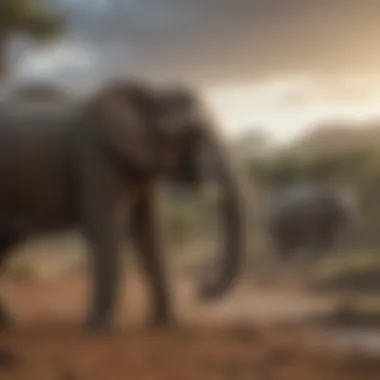
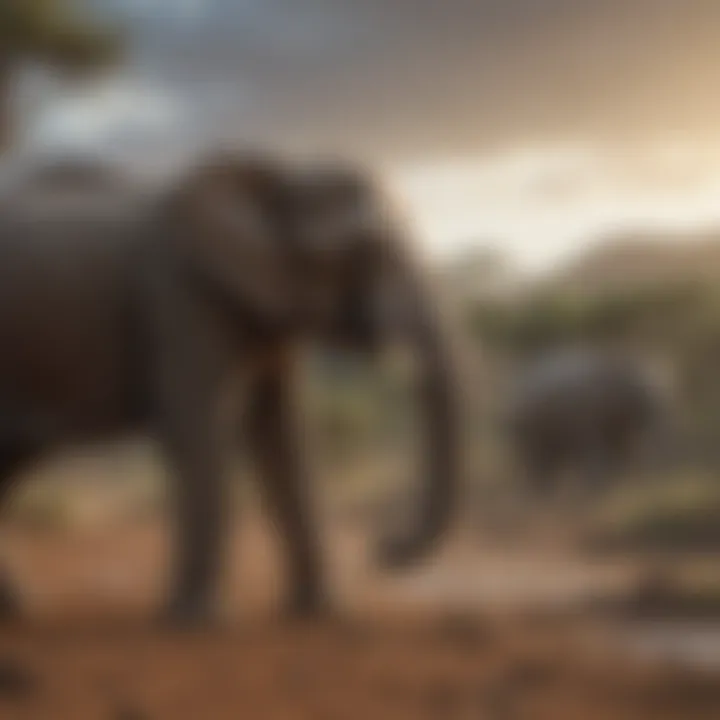
“In terms of ecosystem dynamics, the absence of elephants could lead to forest dieback, reduced biodiversity, and disrupted nutrient cycles.”
Ecosystem Engineers
Apart from being keystone species, elephants can also be classified as ecosystem engineers. Their capacity to modify the environment stems from their size and behavior. Consider how they modify landscapes:
- Habitat Creation: By uprooting trees and trampling underbrush, elephants pave the way for a variety of new habitats, making it easier for smaller creatures and vegetation types to flourish.
- Nutrient Cycling: With their massive dung heaps, elephants play a role in nutrient cycling. Their dung returns vital nutrients to the soil, promoting healthy plant growth and attracting insects and birds, which further supports the ecosystem.
- Forest vs. Savannah: The sheer presence of elephants can influence whether an area remains forested or transitions to savannah. In regions where they thrive, their grazing can help maintain savannah ecosystems, which is populated by different species than dense forests.
Thus, the removal or decline of elephant populations would not just affect the elephants themselves but would destabilize various ecosystems, leading to unforeseen consequences.
Recognizing these roles underscores the urgency of their conservation. The loss of elephants means not only the disappearance of these magnificent creatures but also a threat to the intricate web of life they support. As humans, we have a responsibility to safeguard these natural custodians of ecosystems.
Conservation and Future Challenges
Conservation plays a pivotal role in ensuring the survival of elephants, whose existence is under constant threat from a myriad of factors. Understanding these challenges is crucial in addressing them effectively. In this section, we will delve into the current threats that elephant populations face today, as well as look at strategies for preservation that are being implemented worldwide.
Current Threats to Elephant Populations
Elephants, despite their strength and size, are vulnerable creatures. Their survival is jeopardized mainly by habitat loss, poaching, and human-wildlife conflict. Urban development, agriculture, and mining have caused a significant reduction in their natural habitats. As forests are cleared and land is fragmented, elephants find it increasingly difficult to roam freely.
Poaching remains a grim reality, driven primarily by the demand for ivory. Despite bans on ivory trade, the illegal market thrives. Unscrupulous poachers relentlessly hunt elephants, leaving behind orphaned young and disrupted family units, further jeopardizing the survival of future generations.
Human-wildlife conflict is another growing threat, arising when elephants wander into farmland, resulting in crop destruction. In retaliation, some communities may resort to harming or killing these animals, exacerbating the population decline. Over time, these actions foster a sense of mistrust and resentment between elephants and people, complicating conservation efforts.
Strategies for Preservation
To counter the aforementioned threats, various effective strategies for preservation have been devised. These approaches encompass creating protected areas, enforcing legal frameworks to combat poaching, and fostering community involvement to ensure sustainable coexistence with elephants.
Protected Areas and Legal Frameworks
Protected areas are a cornerstone in elephant conservation. National parks, wildlife reserves, and sanctuaries provide a sanctuary where elephants can live undisturbed. The key characteristic of these areas is that they safeguard natural habitats, allowing ecosystems to flourish alongside elephant populations. These reserves have shown to be a beneficial choice, as they minimize human encroachment and offer elephants a safe haven.
However, creating protected spaces is just half the battle. Strict legal frameworks are equally necessary to enforce conservation laws and curb poaching. For instance, entities like the Convention on International Trade in Endangered Species (CITES) regulate the trade of ivory and other elephant products, thereby restricting illegal activities. The unique feature of such regulations lies in their global reach, requiring cooperation among different nations to effectively tackle poaching on an international scale.
Nonetheless, some challenges still linger. Protected areas often face funding and resource hurdles, limiting their effectiveness in conservation. Furthermore, when wildlife and human populations overlap, conflicts arise, making the need for effective management plans more pressing than ever.
Community Involvement and Awareness
Community involvement is crucial in the journey towards elephant conservation. Engaging local populations not only fosters a sense of responsibility but also creates a network of awareness, promoting coexistence. The key characteristic of community involvement is inclusivity; when communities feel ownership of their local environment, they are more likely to protect it. Grassroots initiatives, educational programs, and tourism can enhance awareness and promote conservation messages.
An interesting aspect of community initiatives is their potential to provide alternative livelihoods. Communities can benefit from eco-tourism, where ethical tours generate income while emphasizing elephant conservation. However, it's important to balance tourism with environmental preservation to avoid overexploitation.
The unique feature of raising community awareness is the empowerment it offers. Local people become advocates for conservation, leading to positive changes in attitudes towards elephants. That said, relying solely on community engagement can be risky; without adequate support and resources, these initiatives may not yield the desired outcomes.
"Without a concerted effort involving legal, ecological, and social strategies, the future of elephants hangs in the balance."
Epilogue: The Continuing Evolution
In reflecting on the evolutionary journey of elephants, it becomes clear that their past is not merely a collection of ancient bones and artifacts. It is a tapestry woven with the threads of survival, adaptation, and ecological significance. The evolutionary history of elephants is marked not only by their grand size and distinctive features but also by their resilience in the face of changing environments and challenges posed by human activity.
Understanding the evolution of elephants is vital for various reasons. For one, recognizing the adaptations that have allowed them to thrive can inform conservation strategies and efforts to preserve their habitat. A focus on their evolutionary journey reveals how previous populations responded to climatic shifts, which can be a guide for current and future efforts to mitigate the impact of climate change on these magnificent creatures.
Additionally, elephants are keystone species, meaning their presence is crucial for maintaining the health of the ecosystems they inhabit. Their roles include seed dispersal and creating pathways for other species through dense vegetation. As we continue to learn about their evolutionary significance, we realize that protecting elephants is not solely about preserving an iconic species; it’s about maintaining the balance of entire ecosystems that rely on them.
This brings us to the pressing issue of conservation. The ongoing threats that elephants face today, from habitat destruction to poaching, call for immediate and deliberate action. Awareness and understanding of their evolutionary place can empower advocacy for their protection and promote initiatives that engage local communities in conservation efforts.
As we stand at the crossroads facing a rapidly changing world, the story of the elephant serves as a powerful reminder of the intricate bonds that connect all living beings within our ecosystems. Their past informs not only their future but also that of the environments they inhabit and the countless species they support. This is an evolution that is ongoing, where each chapter contributes to the narrative of life itself.
Reflections on the Past and Future of Elephants
The evolution of elephants can be seen as both an intricate dance with history and a reflection of the challenges that lie ahead. Each stage of their development points to a complex interplay of environmental circumstances and anthropogenic factors. Historically, elepants adapted through vast geographic ranges and climatic fluctuations, demonstrating not just survival, but a remarkable degree of change.
Looking to the future, the continued evolution of elephants will likely be shaped by our actions. Preservation efforts can help ensure that the narrative does not end in tragedy but instead transforms into a powerful example of recovery and resurgence. This evolution will hinge on the decisions society makes about biodiversity conservation, habitat restoration, and the pursuit of sustainable interactions with wildlife.
"In the eyes of the elephant, we see our own responsibility to protect not just a species, but the vitality of our planet."
As students, researchers, educators, and professionals, it is imperative that we recognize our role in this ongoing story. By integrating knowledge of elephant evolution into broader discussions on biodiversity, ecology, and conservation, we uphold the significance of these creatures not just as relics of the past but as vital players in our ecological present and future.







